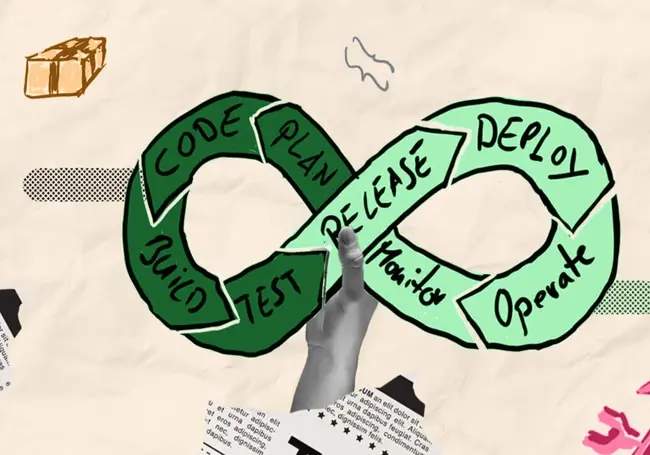
For the past decade, the software industry has been rapidly adopting DevOps, which is a practice that emphasizes smooth collaboration between development and operations teams to achieve a seamless delivery of software.
However, the focus on speed and agility has resulted in a lack of attention to security, leaving software vulnerable to cyber threats.
This is why integrating security into the development process right from the outset has become extremely necessary, which is where DevSecOps comes in.
According to industry projections, the DevSecOps market size is set to increase at a compound annual growth rate (CAGR) of 30.76% between 2022 and 2030, reaching a total value of USD 41.66 billion by 2030.
This is why this blog explores some of the best practices with the help of which organizations can implement and develop secure and resilient software while maintaining the agility and speed of DevOps.
DevOps And Security: A Quick Brief
The DevOps approach aims to bridge the gap between the development and operations teams to deliver high-quality software at a faster pace.
It involves:
The automation of the software delivery processContinuous integration and deployment or CI/CDA culture of collaboration and communication
Best Practices for Building Secure DevOps
Here are some best practices that DevOps organizations must adopt to secure their software from cyber-attacks and threats:
1. Implementing A Culture of Security
It's crucial to establish a culture of trust, transparency, and accountability that prioritizes security.
You can use the following strategies can help build a culture of security:
Educate the Team
Educate your team about the importance of security and encourage them to stay updated on security trends. For this, you can organize regular training sessions centered around security best practices and the latest security threats.
Collaboration
Collaboration is key to building a culture of security.
This is why the development, operations, and security teams should work together to:
Identify security risksPrioritize security measuresImplement security controls
Continuous Improvement
A culture of continuously updating your security measures will encourage teams to do the same and adopt these practices as part of their daily routines.
Here are some tactics to help you identify vulnerabilities and improve your security outlook:
Conduct regular security assessmentsAdopt frequent testingLeverage threat modelingEnsure that your teams also review their security procedures regularly and are aware of the latest security best practices
2. Implementing Security Into The Development Pipeline
You must integrate security into every stage of your continuous integration and delivery (CI/CD) pipeline to build secure software.
Here are three essential practices with the help of which you can make your development pipeline more secure:
Threat Modeling
Threat modeling is the process of identifying and evaluating potential security threats and vulnerabilities in your application.
You can prioritize security risks and implement appropriate security controls to mitigate them by analyzing the following:
System architectureData flowEntry points
Security Testing
Incorporating security testing into your continuous integration and delivery (CI/CD) pipeline is essential for building secure software.
You can use automated security testing tools to:
Scan code for vulnerabilities and security flawsProvide feedback to developersValidate authentication and authorization controlsPerform testing to identify potential weaknesses in the application
Secure Coding Practices
Developers must be trained in secure coding practices to build secure software.
This includes using secure coding standards and practices, such as:
Input validationOutput encodingProper error handling
3. Implementing Security For Deployment
Deploying secure software requires that security considerations are also integrated into the deployment process, such as the ones outlined below:
Configuration management
You can use version control to track configuration changes which will help prevent accidental or unauthorized changes. You can also automate configuration management tasks, to ensure consistency and reduce the risk of human error.
Deployment automation
Automating the deployment process can help improve security by reducing the chance of manual errors.
It also ensures that deployments are performed consistently and that all security-related steps are taken care of before the code is deployed.
According to IBM's 2022 report, companies that have fully implemented AI automation were able to detect and contain data breaches 28 days faster than those without such automated tools.
It resulted in cost savings of a whopping $3.05 million.
Secure access management
Secure access management involves granting the right level of access to the right people, with the following:
Zero trust principlesLeast privilege accessRole-based access control (RBAC)Multi-factor authentication (MFA)
Best Practices for Building Resilient DevOps
It's crucial to establish resilient DevOps practices to ensure your software can withstand unexpected events like:
Cyber-attacksNetwork failuresSystem outages
This means prioritizing best practices that focus on the following:
1. Continuous Monitoring
Continuous monitoring involves implementing security and app performance into your development pipeline.
It allows team leaders to track and detect potential security issues in real time.
This gives you the autonomy to take swift action to resolve any problems.
Your DevOps teams can use log monitoring and APM tools to identify issues before they impact the end users and resolve them quickly.
2. Resilient Architecture
Creating a resilient architecture is another key component of enhancing your DevOps practices.
This means that you must design systems that can withstand unexpected events and minimize disruptions. You can achieve this by implementing fail-over mechanisms and redundancy.
3. Regularly Testing the Resilience
Regularly testing resilience is critical to ensuring that your DevOps practices stay secure.
You can do so with the help of the following processes:
Load testing
It can help identify areas of your system that are vulnerable to overload.
Disaster recovery testing
This can help identify weaknesses in your system's ability to recover from unexpected events.
In Conclusion…
Thus, briefly speaking, building secure and resilient software requires a shift in mindset and a culture of collaboration between security and development teams.
You can implement the following DevOps security best practices to do so:
Embedding security into the development pipelineSecuring deploymentBuilding resilience through continuous log monitoring and testing












Comments ( 1 )